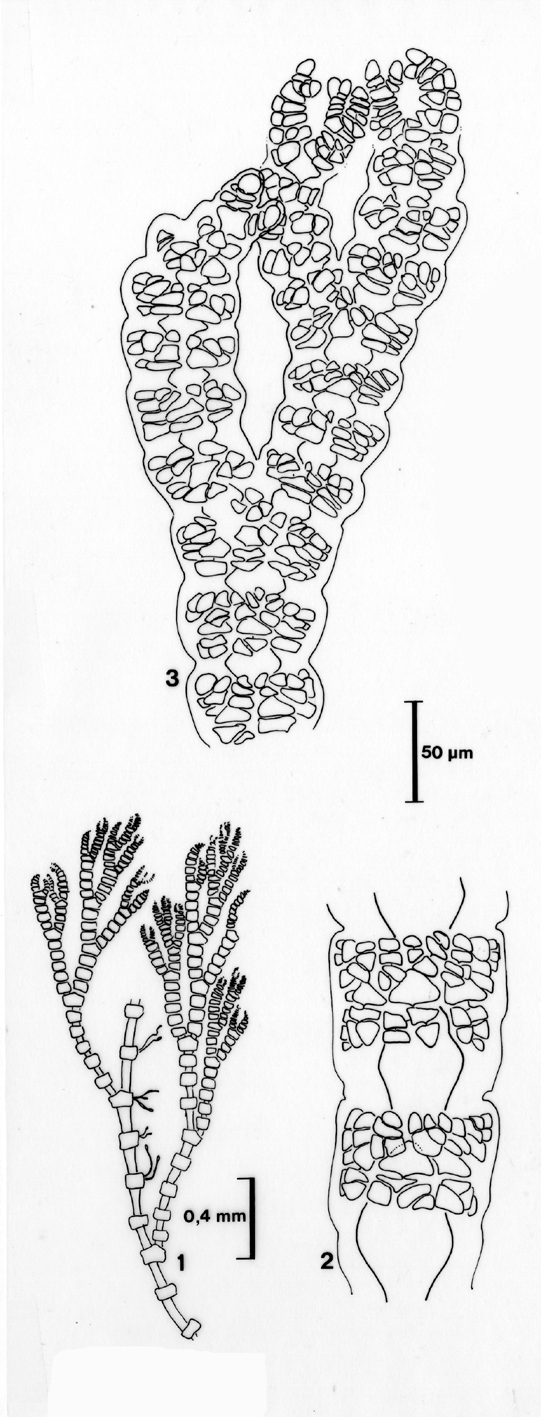Seaweeds of the South African South Coast


Order Ceramiales
Family Ceramiaceae
Gayliella dawsonii = Ceramium dawsonii A.B. Joly 1957: 150-152, pl. XIX: figs. 1, 1a, 1b, 1c, 1d ('dawsoni')
According to the morphological criteria of Cho et al. (2008), this species should belong to Gayliella, but no formal transfer has been made.
Plants partly creeping, with erect part up to 2 cm but often smaller, the creeping parts attached by up to three rhizoids per segment, arising from the periaxial cells. Apices moderately to little incurved. Thallus alternately branched at intervals of 3-6 segments, diameter varying for 20 µm (apex) to 120 µm. Segments with 5-6(-7) periaxial cells, each producing two acropetal and one basipetal corticating group initials, periaxial cells remaining partly exposed. Cortication usually limited to two (horizontal) rows basipetally and three rows acropetally, the two separated strictly. Cortication incomplete, the uncorticated part of the central cells shorter than broad in young parts of the thallus, much longer in basal (creeping) parts. Acropetal cell groups sometimes with a few gland cells.
Tetrasporangia borne by periaxial cells, ca. 45 µm in length, tetrahedrally divided, largely immersed in the cortex, causing considerable swelling of the segment. Spermatangia on subapical sections of the thallus. Carposporophytes small, consisting of one or two gonimoblasts with few (about 10) spores up to 40 µm in diameter. Involucral filaments about six.
Collections, ecology and regional distribution
A very common species over the whole of the south coast from False Bay eastward (17-56 ) as well as from Namibia and Natal (as Ceramium flaccidum – Rull Lluch 2002, De Clerck et al. 2005 – see note below). The material is known from a wide variety of substrata, mostly other algae.
World distribution: Caribbean, Atlantic South America (references cited in Guiry & Guiry, Nov 2015), but see note below.
Type locality: Paranapoan, Brazil (Silva et al. 1996).
Note: The precise relationship of C. flaccidum to the present species (and C. papenfussianum from the west coast) remains to be established. C. flaccidum is typified by a specimen from south-west England and grows up to 12 cm tall and has internodes 8-12 times as long as broad (Maggs & Hommersand 1993). Descriptions of southern African material agree on a maximum size of 2 cm of the upright parts (De Clerck et al. 2005, Rull Lluch 2002), the maximum observed length of the internodes is 5 times the diameter.

Gayliella dawsonii (= Ceramium dawsonii, see note). 1. Microscopic habit. 2. Detail of older segments. 3. Thallus apex. Reproduced from Stegenga et al. (1997), as Ceramium dawsonii).
References Gayliella dawsonii
De Clerck, O, Tronchin, E. M., Schils, T. 2005. Red algae. In: De Clerck, O., J.J. Bolton, R. J. Anderson and E. Coppejans, 2005. Guide to the Seaweeds of Kwazulu-Natal. National Botanic Garden of Belgium, Brussels (Scripta Botanica Belgica), pp. 130-269.
Guiry, M.D. & Guiry, G.M. 2015. AlgaeBase. World-wide electronic publication, National University of Ireland, Galway. http://www.algaebase.org; searched on 17 November 2015.
Joly, A.B. 1957. Contribuição ao conhecimento da flora ficológica marinha da Baía de Santos e Arredores. Boletim da Faculdade de Filosofia, Ciências e Letras da Universidade de São Paulo, Botânica 14: 3-199, 3 figs, 19 plates, map, graph.
Maggs, C.A. & Hommersand, M.H. 1993. Seaweeds of the British Isles. Volume 1. Rhodophyta. Part 3A. Ceramiales. pp. [i]-xv, 1-444, 129 figs, map. London: HMSO.
Rull Lluch, J. 2002. Marine benthic algae of Namibia. Scientia Marina 66 (Supplement 3): 258 pp.
Silva, P.C., Basson, P.W. & Moe, R.L. 1996. Catalogue of the benthic marine algae of the Indian Ocean. University of California Publications in Botany 79: 1-1259.
Stegenga, H., Bolton, J.J. & R. J. Anderson. 1997. Seaweeds of the South African west coast. Contributions from the Bolus Herbarium 18: 655 pp.
Cite this record as:
Anderson RJ, Stegenga H, Bolton JJ. 2016. Seaweeds of the South African South Coast.
World Wide Web electronic publication, University of Cape Town, http://southafrseaweeds.uct.ac.za; Accessed on 07 January 2026.